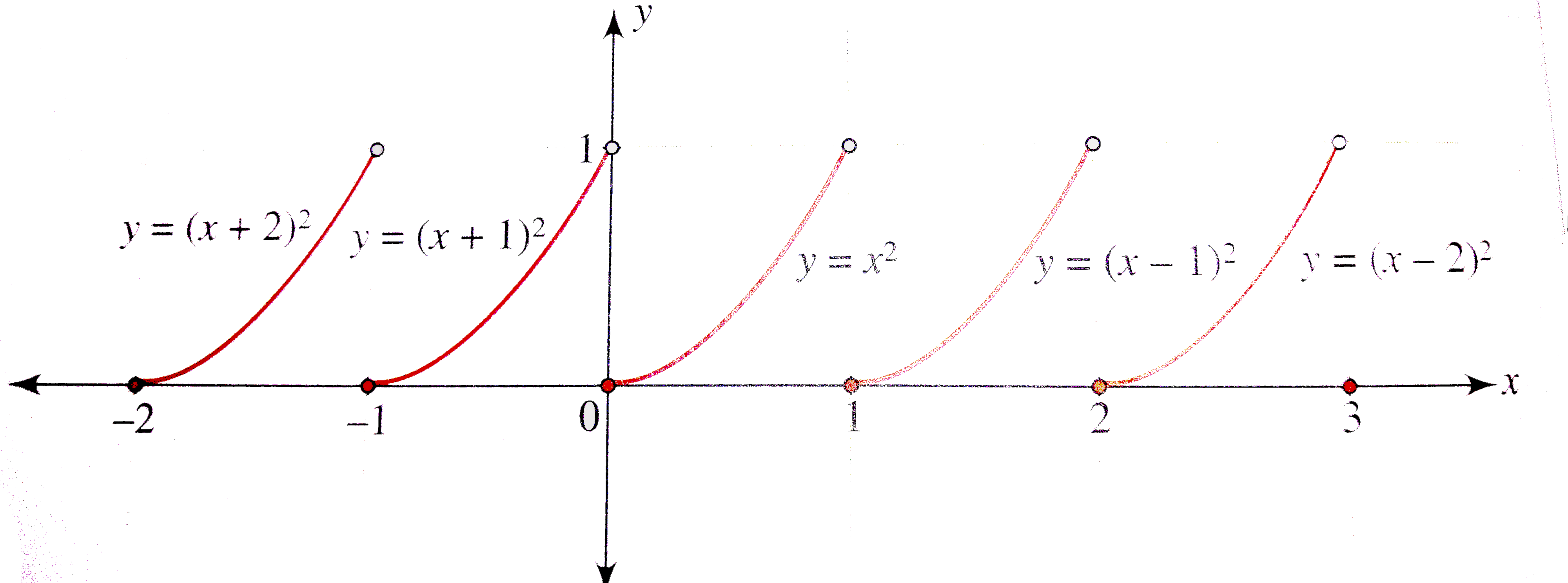limx→cf(x) does not exist for
wher [.] represent greatest integer function {.} represent fractional part functionSolution in Bengali
We have y=f(x)={x}2
or y=(x−[x])2
Since 0≤{x}<1,0≤{x}2<1.
For 0≤x<1,y=x2, which is a half parabola to the right of the vertex at (0,0).
For 1≤x<2,y=(x−1)2, which is a half parabola to the right of the vertex at (1, 0).
For 2≤x<3,y=(x+1)2, which is a half parabola to the right of the vertex at (2, 0).
For −1≤x<0,y=(x+1)2, which is a half parabola to the right of the vertex at (−1,0), and so on.
The graph of the function is as shown in the following figure.

Topper's Solved these Questions
- BOOK - CENGAGE PUBLICATIONCHAPTER - GRAPHS OF ELEMENTARY FUNCTIONS EXERCISE - EXERCISES34videos
GRAPHS OF ELEMENTARY FUNCTIONS
- BOOK - CENGAGE PUBLICATIONCHAPTER - GRAPHS OF POLYNOMIAL AND RATIONAL FUNCTIONSEXERCISE - Exercises17videos
GRAPHS OF POLYNOMIAL AND RATIONAL FUNCTIONS
- BOOK - CENGAGE PUBLICATIONCHAPTER - GRAPHS OF TRIGONOMETRIC FUNCTIONSEXERCISE - Exercises22videos
GRAPHS OF TRIGONOMETRIC FUNCTIONS
Similar Questions
Draw the graph of y=1(1/x).
02:29View SolutionDraw the graph of y=(x−1)(x2−x+1).
06:11View SolutionDraw the graph of y= cosec 2x−cot2x. Is f(x) periodic ? If yes, what is its fundamental period ?
05:09View SolutionSolve the equation [x]+{-x}=2x, (where [.l and {} represents greatest integer function fractional part function respectively)
02:07View SolutionSolve the following equations (where [*] denotes greatest integer function and {*} represent fractional part function and sgn represents signum function)
03:35View Solutionlimx→cf(x) does not exist for
wher [.] represent greatest integer function {.} represent fractional part function01:49View SolutionFind the range of each of the following functions: (where {.} and [.] represents fractional part and greatest integer part functions respectively)
f(x)=11+√x04:32View SolutionFind the range of each of the following functions: (where {.} and [.] represents fractional part and greatest integer part functions respectively)
f(x)=[1sin{x}]02:05View SolutionFind the range of the following functions: (where {.} and [.] represent fractional part and greatest integer part functions respectively)
f(x)=1−|x−2|02:54View SolutionFind the range of the following functions: (where {.} and [.] represent fractional part and greatest integer part functions respectively)
f(x)=x4−2x2+502:04View SolutionFind the range of the following functions: (where {.} and [.] represent fractional part and greatest integer part functions respectively)
f(x)=sin2xcos4xView SolutionProve that limx→2[x] does not exists, where [.] represents the greatest integer function.
06:23View SolutionProve that limx→2[x] does not exists, where [.] represents the greatest integer function.
11:54View SolutionThe domain of definition of the function f(x)={x}{x}+[x][x] is {.} represents fractional part and {.} represents fractional part and [.] represents greatest integral interal function
01:47View SolutionFunction f (x)= {x} sin ( pi[x]) , Where [.] Represents the greatest integer = function and {.} The fractional part function, is discrete at the following:
05:01View Solutionlimx→cf(x) does not exist for
wher [.] represent greatest integer function {.} represent fractional part function04:00View Solution

